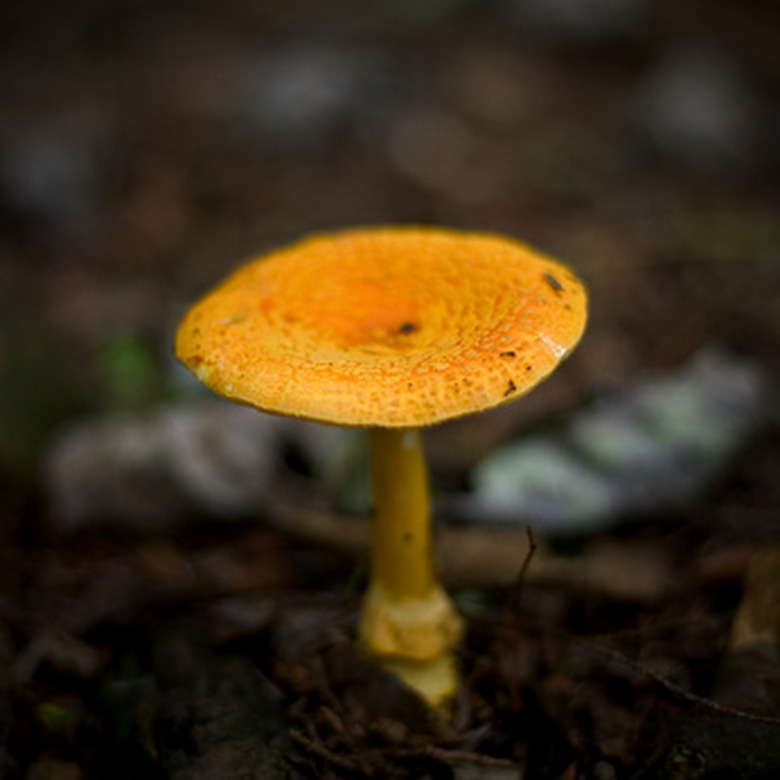How To Find Wild Edible Mushrooms In Tennessee
Wild edible mushrooms are a rare, savory treat and can constitute a unique challenge to find. The edible varieties in Tennessee come in all shapes and sizes, including one variety that grows as large as a chicken. The best area in general for mushroom hunting in Tennessee is Countryside.
Step 1
Go to areas with high populations of oak trees to find a giant mushroom known as the Hen of the Woods, or Grifola frondosa. This mushroom resembles a hen with ruffled feathers both in size and appearance. It is a pale tan mushroom that typically weighs between 7 and 10 pounds. You can hunt for this mushroom in the fall. Hen of the Woods is found in the Cumberland Mountains in the fall.
- Wild edible mushrooms are a rare, savory treat and can constitute a unique challenge to find.
- Go to areas with high populations of oak trees to find a giant mushroom known as the Hen of the Woods, or Grifola frondosa.
Step 2
Search for morels in the spring in moist areas. These mushrooms are small, cream colored and have a sponge-like head. The best places to search for these tasty delicacies are near dead trees, in sandy soil and under periwinkle vines. The best places to hunt morels in Tennessee are Cross Plains, Nanchez Trace, Summertown, Hendersonville and Clarksville.
Step 3
Look for the sweet tooth, or hydnum repandum, around birch trees in August through November. The head of this mushroom is between 2 and 8 inches wide and orange to light brown in color. You will recognize this mushroom by its small, darker colored teeth that break off when the mushroom is handled. These mushrooms grow in groups, so be on the lookout for more than one. The best region for hunting sweet tooth mushrooms in Tennessee is in the national forest.
- Search for morels in the spring in moist areas.
- You will recognize this mushroom by its small, darker colored teeth that break off when the mushroom is handled.
Grow Edible Mushrooms Inside
Soak straw in large tubs of water for one day. Cover the pile with burlap, and let it rest for one week. Sprinkle water on areas that are dry or white. Mix dry flake mushroom spawn into the compost at a rate of 1 quart per 15 cubic feet, one week after you finish turning the pile. Place trays in a cool location out of direct sunlight, and ventilated with windows or a fan. Fill the trays using the finished inoculated compost, leaving it in heaps for 24 hours, then flatten the compost into the trays with a brick or piece of wood. Add or remove soil from the tray so you have 2 inches at the top of the tray with no soil. Maintain a compost temperature of 65 to 70 degrees Fahrenheit during the first two weeks by using a germination mat if necessary. Cover the trays of compost with a 1-inch layer of this moistened soil or peat, called "casing."
- Soak straw in large tubs of water for one day.
- Fill the trays using the finished inoculated compost, leaving it in heaps for 24 hours, then flatten the compost into the trays with a brick or piece of wood.
Warning
Eating unidentified mushrooms can result in severe sickness and death. Always be sure you are picking and eating mushrooms that are known to be safe.
References
- Mushroom-Collecting.com: Hedgehog/Sweet Tooth Mushroom
- AmericanMushrooms.com: The Sweet Tooth Or Hedgehog Mushroom
- U.S. Forest Service: Gyromitra montana Harmaja
- University of Kentucky Cooperative Extension Service: Truffles & Other Edible Mycorrhizal Mushrooms
- Cornell University Cooperative Extension: Growing Button Mushrooms
- Mycological Society of San Francisco: Scientific and Common Names of Mushrooms
